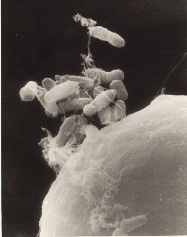Rhizobiaceae
The Rhizobiaceae is a family of proteobacteria comprising multiple subgroups that enhance and hinder plant development.[4] Some bacteria found in the family are used for plant nutrition and collectively make up the rhizobia. Other bacteria such as Agrobacterium tumefaciens and A. rhizogenes severely alter the development of plants in their ability to induce crown galls or hairy roots found on the stem.[4] The family has been of an interest to scientists for centuries in their ability to associate with plants and modify plant development.[4] The Rhizobiaceae are, like all Proteobacteria, Gram-negative. They are aerobic, and the cells are usually rod-shaped.[5] Many species of the Rhizobiaceae are diazotrophs which are able to fix nitrogen and are symbiotic with plant roots.
| Rhizobiaceae | |
|---|---|
 | |
| Agrobacterium tumefaciens as it begins to infect a carrot cell | |
| Scientific classification | |
| Kingdom: | Bacteria |
| Phylum: | |
| Class: | |
| Order: | |
| Family: | Rhizobiaceae Conn 1938 |
| Type genus | |
| Rhizobium | |
| Genera[1] | |
| |
Relation to Agrobacterium
Agrobacterium has been recognized as being related to the Rhizobium.[6] Evidence supporting the association was conducted by phylogentic inferences based on 16S rDNA sequence analyses showing the genera could not be distinguished as separate monophyletic clades.[6]
Phylogeny
The currently accepted taxonomy is based on the List of Prokaryotic names with Standing in Nomenclature (LPSN)[1] and the National Center for Biotechnology Information (NCBI),[7] and the phylogeny is based on 16S rRNA-based LTP release 106 by The All-Species Living Tree Project [8]
| |||||||||||||||||||||||||||||||||||||||||||||||||||||||||||||||||||||||||||||||||||||||||||||||||||||||||||||||||||||||||||||||||||||||||||||||||||||||||||||||||||||||||||||||||||||||||||||||||||||||||||||||||||||||||||||||||||||||||||||||||||||||||||||||||||||||||||||||||||||||||||||||||||||||||||||||||||||||||||||||||||||||||||
References
- J.P. Euzéby. "Proteobacteria (scroll down for Rhizobiaceae)". LPSN. Archived from the original on 2013-01-27. Retrieved 2012-05-02.
- Mousavi SA, Willems A, Nesme X, de Lajudie P, Lindström K (2015). "Revised phylogeny of Rhizobiaceae: proposal of the delineation of Pararhizobium gen. nov., and 13 new species combinations". Syst Appl Microbiol. 38 (2): 84–90. doi:10.1016/j.syapm.2014.12.003. PMID 25595870.
- Kimes NE, López-Pérez M, Flores-Félix JD, Ramírez-Bahena MH, Igual JM, Peix A, Rodriguez-Valera F, Velázquez E (2015). "Pseudorhizobium pelagicum gen. nov., sp. nov. isolated from a pelagic Mediterranean zone". Syst Appl Microbiol. 38 (5): 293–299. doi:10.1016/j.syapm.2015.05.003. PMID 26078205.
- Spaink, Herman P.; Kondorosi, Adam; Hooykaas, Paul (2012-12-06). The Rhizobiaceae: Molecular Biology of Model Plant-Associated Bacteria. Springer Science & Business Media. ISBN 9789401150606.
- Garrity, George M.; Brenner, Don J.; Krieg, Noel R.; Staley, James T. (eds.) (2005). Bergey's Manual of Systematic Bacteriology, Volume Two: The Proteobacteria, Part C: The Alpha-, Beta-, Delta-, and Epsilonproteobacteria. New York, New York: Springer. ISBN 978-0-387-24145-6.
- Young, J. M.; Kuykendall, L. D.; Martínez-Romero, E.; Kerr, A.; Sawada, H. (2003-01-01). "Classification and nomenclature of Agrobacterium and Rhizobium – a reply to Farrand et al. (2003)". International Journal of Systematic and Evolutionary Microbiology. 53 (5): 1689–1695. doi:10.1099/ijs.0.02762-0. PMID 13130069.
- Sayers; et al. "Rhizobiaceae". NCBI taxonomy database. Retrieved 2012-05-02.
- All-Species Living Tree Project."16S rRNA-based LTP release 106 (full tree)" (PDF). SILVA RDB. Retrieved 2012-05-02.
- These species were formerly classified in the genus Agrobacterium.
- This is the type species for the genus.
- Arthrobacter viscosus is currently classified in the Micrococcaceae. See Arthrobacter.
- Species found in the genera Aurantimonas, Aureimonas, Fulvimarina, and Martelella are all currently classified in the Aurantimonadaceae.
- The species in the genus Aureimonas were formerly classified in the genus Aurantimonas.
- Beijerinckia fluminensis is currently classified in the Beijerinckiaceae.
- This includes Agrobacterium tumefaciens (Smith and Townsend 1907) Conn 1942.
- Blastobacter capsulatus is currently classified in the Bradyrhizobiaceae.
- These species were formerly classified in the genus Sinorhizobium.